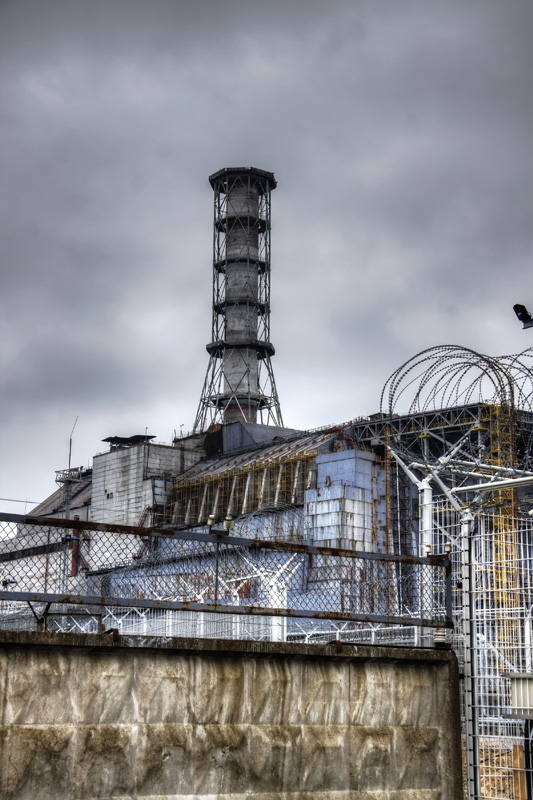
LOCATION Kiev Oblast, Ukraine
NEAREST POPULATION HUB Kiev
SECRECY OVERVIEW Access restricted: the now-deserted scene of the world’s worst nuclear accident.
In 1986, Chernobyl in the Ukraine was the scene of the most devastating nuclear disaster in history. An Exclusion Zone around the site of the reactor that exploded, sometimes known as the Zone of Alienation, extends for 30 kilometers (19 miles) and remains a largely no-go area for all but a small community of researchers tracking the continuing impact of the tragedy.
Construction of the Chernobyl Nuclear Power Plant, situated close to the border of the Ukraine and Belarus, began in 1970. At that time, the Ukraine was one of the constituent states of the Soviet Union, and the plant was officially called the V.I. Lenin Nuclear Power Station. An entire city, Pripyat, was built at the same time to provide homes for the plant’s workers and their families. The first reactor went into service in 1977, and three more were running by 1983. Two more reactors were under construction when disaster struck on April 26, 1986.
By that stage, Chernobyl’s four reactors were producing about 10 percent of the Ukraine’s electricity. However, the plant already had a somewhat calamitous history—in 1982, Reactor No. 1 suffered a partial meltdown that was covered up by the communist regime in Moscow. But this incident paled in comparison to what happened to Reactor 4 on that April Saturday. A power surge led to a series of explosions within the reactor, exposing its graphite moderator, which then caught fire. Vast clouds of radioactive smoke rose into the skies over Europe, with the highest proportion of fallout landing on Belarus. Large-scale releases of radionuclides continued for ten days after the accident, and it is estimated that some 200,000 square kilometers (80,000 square miles) of Europe suffered at least some contamination.
The immediate priority for the government in Moscow was crisis containment. The 53,000 inhabitants of Pripyat were not evacuated until the following day, and news of the disaster was not broadcast until the following Monday, and then only as a television announcement lasting less than 30 seconds. The longer-term impact of events at Chernobyl is hard to calculate—Soviet figures attributed just 31 deaths to the disaster, but other health experts suggest that tens of thousands might eventually die of cancers related to the effects of the fallout.
The Soviet government incurred massive expense in attempting a clean-up and relocating more than 350,000 people from areas in peril. Agriculture and forestry in the area around Chernobyl was devastated, with the loss of 800,000 hectares (2 million acres) of farmland and 700,000 hectares (1.7 million acres) of forest from productive use. Some have suggested that the disaster cost the economy hundreds of millions of dollars over the years that followed, and hastened the USSR’s economic collapse.
Reactor 4 itself was hastily encased in a concrete and steel “sarcophagus.” Doubts as to its long-term safety were expressed by some in the scientific community, and in 2007 it was reported that a new steel containment structure costing US$1.4 billion would be built by 2013. Amazingly, Chernobyl continued to operate for many years after the disaster. In 1991 another fire broke out (this time in Reactor 2), and it was only in 2000 that the plant was finally closed down by the now-independent Ukrainian government. Nonetheless, decommissioning is expected to last for many more years.

FINAL RESTING PLACE Shortly after the initial disaster in 1986, a metal and concrete sarcophagus was hastily erected over Reactor 4 to lock in some 250,000 tons of radioactive materials. Amid concerns about its structural integrity, there are now plans to build a replacement “New Safe Confinement” structure.
As for the citizens of Pripyat, they were commanded to abandon their previous lives with virtually no notice. Most were unceremoniously forced on to buses by armed soldiers in an afternoon. Many left assuming they would soon return. They never have, and today Pripyat stands abandoned. A rusty, lonely-looking Ferris wheel that once brought pleasure to the town’s visitors is now one of the more potent symbols of what happened at Chernobyl. Many of its inhabitants have subsequently complained of health problems, both physical and psychological. Indeed, the Chernobyl Forum (an initiative of the International Atomic Energy Agency) reported that “the mental health impact of Chernobyl is the largest public health problem unleashed by the accident to date.”
The area covered by the Exclusion Zone has been subject to minor alterations over the years, and pollution levels within its boundaries are highly variable. It remains, though, predominantly uninhabited, save for a few returned ex-residents and some squatters, all of whom live there without official permission but are broadly tolerated by the authorities. Spread across the zone are at least 800 “burial grounds” for abandoned, contaminated vehicles. The perimeter is constantly patrolled by police and military, with visitors forced to present their documentation at checkpoints. Most who enter are carrying out scientific research work or are employed in the lengthy decommissioning process.
1 SCATTERED DEBRIS More than 1,000 square kilometers (380 sq miles) of land directly around Chernobyl were blanketed with dangerous heavy elements following the explosion. Lighter radioactive isotopes were scattered across much of Europe, affecting agriculture for years.
2 ABANDONED DREAMS A deserted classroom stands eerie and silent witness to the devastation wrought by the Chernobyl disaster. The entire area was hurriedly evacuated and those who dare venture back today can expect to find an unsettling world reminiscent of a modern-day Marie Celeste.